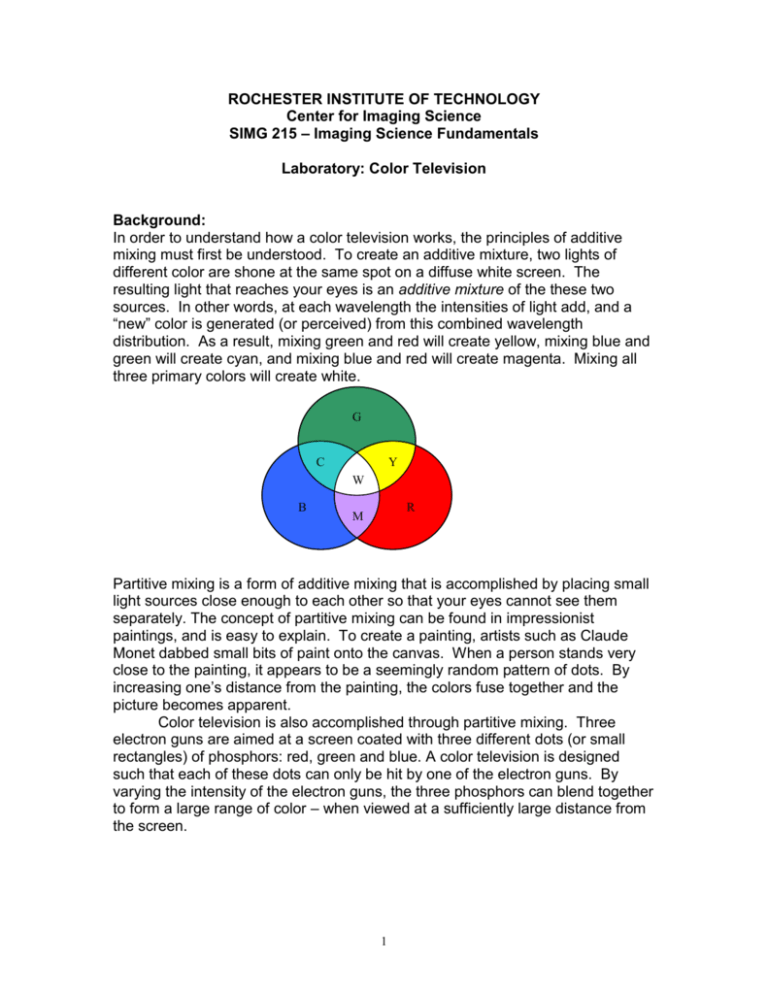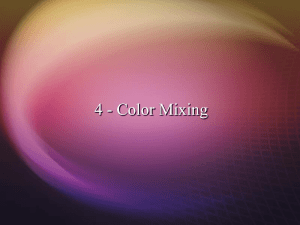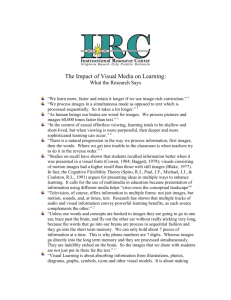Carlson Center for Imaging Science
advertisement

ROCHESTER INSTITUTE OF TECHNOLOGY Center for Imaging Science SIMG 215 – Imaging Science Fundamentals Laboratory: Color Television Background: In order to understand how a color television works, the principles of additive mixing must first be understood. To create an additive mixture, two lights of different color are shone at the same spot on a diffuse white screen. The resulting light that reaches your eyes is an additive mixture of the these two sources. In other words, at each wavelength the intensities of light add, and a “new” color is generated (or perceived) from this combined wavelength distribution. As a result, mixing green and red will create yellow, mixing blue and green will create cyan, and mixing blue and red will create magenta. Mixing all three primary colors will create white. G C Y W B R M Partitive mixing is a form of additive mixing that is accomplished by placing small light sources close enough to each other so that your eyes cannot see them separately. The concept of partitive mixing can be found in impressionist paintings, and is easy to explain. To create a painting, artists such as Claude Monet dabbed small bits of paint onto the canvas. When a person stands very close to the painting, it appears to be a seemingly random pattern of dots. By increasing one’s distance from the painting, the colors fuse together and the picture becomes apparent. Color television is also accomplished through partitive mixing. Three electron guns are aimed at a screen coated with three different dots (or small rectangles) of phosphors: red, green and blue. A color television is designed such that each of these dots can only be hit by one of the electron guns. By varying the intensity of the electron guns, the three phosphors can blend together to form a large range of color – when viewed at a sufficiently large distance from the screen. 1 Materials: Convex lens with focal length of 2 inches or less (eyepiece from telescope kit) Color television with reasonably large screen Color monitor (desktop computer CRT) Procedure: 1. With the screen turned off, use the convex lens to magnify & examine the television screen. Make sure the magnified image is in good focus. It helps to leave the eyepiece in its styrofoam holder, as this way you can put the entire eyepiece assembly (lens in styrofoam holder) right against the screen. You may have to push on the styrofoam a bit to get the lens close enough to the screen to achieve best focus. Record your observations. 2. Turn the television on to a color broadcast and again examine the television screen with the convex lens. Make sure the magnified image is in good focus. Again record your observations, taking note of the relative intensities of colors as the broadcast proceeds. 3. Now examine black and white televised images. There are two ways to accomplish this: (a) find a channel that broadcasts in black and white (“I Love Lucy” on Nick at Night?); or (b) if you can’t find such a show, turn down the color control until the screen is in black and white. Again use the convex lens to examine the television screen, and record your observations, taking note of the relative intensities of colors as the broadcast proceeds. 4. Repeat steps 1 and 2 for the color monitor (CRT) of a desktop computer. For step 2, note the magnified screen’s appearance for different colored regions of the screen (for ex., compare the background color with a different color in a foreground window). Also note the magnified screen’s appearance within a bright white region, and with what appears to be a black region. (A Word document like this one makes a good subject for the “black and white” comparison.) Questions to be addressed in “Results” section of report: 1. Based on your observations, how do color CRT screens accomplish the task of generating any color within the visible light spectrum? Give at least two specific examples. 2. Use your observations to contrast the magnified appearance of the computer screen for regions of different color, for white, and for black. 3. Based on your observations, can you explain the fundamental difference in the way the TV is using the partitive color concept for B&W vs. color? 4. How does the color television set’s screen differ from the color computer monitor? Can you explain these differences in terms of differences in the way TVs and computer monitors are typically used? 2







